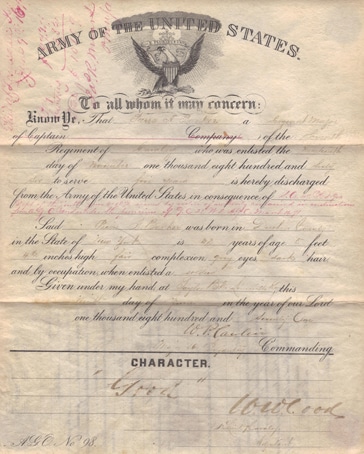If you collect items associated with the Seventh Cavalry, I can help you there also. Shown is the Army Discharge for Pierre A. Banker, who served in 1871 as the senior enlisted man in the regiment.
- Born in Poughkeepsie, Dutchess County, New York on December 5, 1845, the son of John Banker and Priscilla Alden.
- Educated at the Mount Pleasant Military Academy in Ossining, New York at the same time as James “Jimmy” Calhoun.
- Served as a private in Company A of the 20th Regiment, New York State Militia, from the beginning of the Civil War; the regiment was reorganized into the 80th New York Volunteers; it fought at Second Bull Run, Antietam, Fredericksburg, Gettysburg and the Siege of Petersburg; Banker was originally discharged on February 3, 1865.
- Enlisted in the 7th Cavalry Regiment on November 19, 1866.
- Stood 5′ 4½” tall, with a fair complexion, gray eyes and dark hair.
- Served in Company F.
- Fought at the Battle of the Washita and succeeded Sergeant Major Walter Kennedy, who was killed during the battle, as the regimental sergeant major.
- Functioned as a clerk at 7th Cavalry Headquarters at Fort Hays and Fort Leavenworth, where he transcribed many of the original reports submitted by Custer, including the official final report on the Battle of the Washita.
- Wrote a letter to his father, John Banker of New York, which read in part: “I wish Congress would decide upon this Mormon business. I should very much like to go to Salt Lake and give old Brigham a good sound whipping.”
- Discharged from the 7th Cavalry on June 9, 1871 at Taylor Barracks, Louisville, Kentucky. Discharge was signed by Major W. P. Carlin, Commanding Officer of the 16th Infantry Regiment and Post Commander; and by First Lieutenant William W. Cooke, Adjutant of the 7th Cavalry Regiment.
- Married Miss Julia Carroll, daughter of William Carroll a prominent merchant and businessman, in Rhinebeck, New York, on November 23, 1873.
- Graduated from the New York Homeopathic College in 1879 and began practicing medicine.
- Died at Elizabeth, New Jersey on December 2, 1909 of a heart attack.
- Survived by his wife and children, George T. Banker (organist), Pierre Augustine Banker, Jr., Harriett Preston and Julia Carroll Banker.
